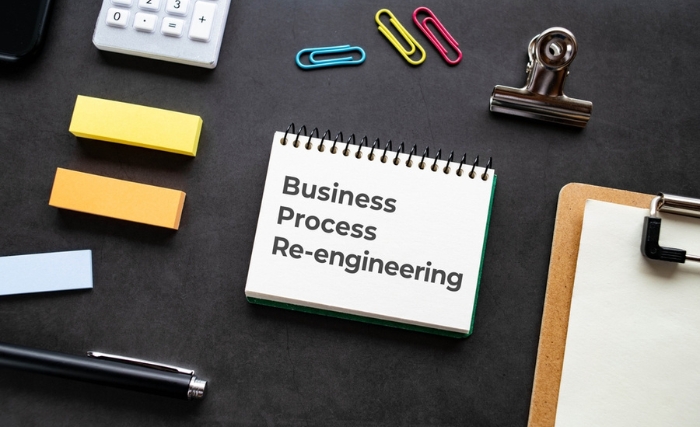
Corporate competition can sometimes feel like a marathon where standing still means falling behind. In this challenging, invigorating world, how does a business maintain its edge, evolve, and surge ahead? One answer might lie in the art of Business Process Re-Engineering (BPR).
BPR represents a comprehensive overhaul of the strategic, operational, and even cultural dimensions of an organisation. If you’re part of an enterprise striving for excellence in efficiency, customer-centricity, and overall performance, then it’s crucial to understand how re-engineering the business process can help you achieve this.
The Fundamentals of BPR
The power of BPR is that it isn’t a mere tweaking of processes or a revision of standard operating procedures; it is a fundamental rethink. It came to prominence in the 1990s, promulgated by Michael Hammer and James Champy in their seminal work ‘Re-engineering the Corporation.’
At its core, BPR challenges the traditional practice of starting from a company’s existing structure and operations. Instead, it advocates starting from a clean slate to define company goals by directly assessing business processes holistically and rethinking them from a ‘zero-base’.
The Methodology
The methodology of BPR is both art and science in equal measures. It begins with identifying ‘core’ business processes and then goes on to analyse every step, decision, and sub-processes. After identifying the business processes needing the most attention, the BPR methodology asks the question, “Why do we do it this way?” followed by “How can we do it better?” and then “Should we do it at all?”
Core Principles
Four critical principles form the bedrock of BPR:
- Organise around outcomes, not tasks
- Have those who use the output of the process perform the process
- Subsume information-processing work into the actual work that produces the information
- Treat geographically dispersed resources as though they were centralised
The Importance of BPR in Modern Business
In an era where transformation is becoming a survival imperative, BPR provides the structured framework within which transformation efforts can take root and flourish. Across diverse industries, from finance to manufacturing and food and beverage production, the power of BPR acts as the catalyst for organisational change.
A Competitive Edge
The undeniable fact is that BPR, when correctly applied, not only helps companies survive but also secures a competitive edge. The relentless focus on efficiency and customer satisfaction is a pathway to sustained market leadership.
Navigating the Complexity
The modern business environment is a complex web of stakeholders, regulations, and technologies. One of the benefits of BPR is its ability to simplify and optimise processes effectively, creating a roadmap for navigating complexity and flourishing within it.
How BPR Leads to Efficiency Improvements
Efficiency is the holy grail of any corporate exercise, and there are several ways in which BPR can help in its pursuit. The process of eliminating redundant steps, minimising the use of resources, and smoothing information flow collectively drive exceptional efficiency gains.
Identifying Bottlenecks and Redundancies
One of the core activities of BPR is to identify and eliminate bottlenecks, which are steps in a process that slow down operational speed and can have repercussions on various aspects of a business. By identifying and addressing these, BPR paves the way for a much smoother operational pathway.
Streamlining Operations
Complex processes are a source of inefficiency. Streamlining operations through the lens of BPR ensures that complexity is replaced with clarity and convolution with conciseness.
Boosting Customer Satisfaction Through BPR
Serving the customer in the best possible manner is the credo of customer-oriented businesses. One of the benefits of BPR is that it can enhance customer satisfaction by aligning processes directly with customer needs.
Understanding the Customer Journey
BPR starts with a thorough understanding of the customer’s needs and the process they go through when interacting with your business. By understanding this customer process and adapting your business process to it, BPR ensures that customer satisfaction is embedded within every part of your organisation.
Fine-Tuning for Responsiveness
Efficient processes are inherently more responsive, and a triumphant fusion of BPR and customer satisfaction is in responsiveness. By fine-tuning processes to be more responsive, BPR ensures that customers feel the business is tuned into their needs.

Enhancing Overall Business Performance with BPR
At the end of the day, business performance is the culmination of numerous factors, and BPR is a significant contributor.
The impact of BPR isn’t unidirectional; in fact, it has a 360-degree influence. Improvement in one area often leads to a cascade of benefits across multiple business areas and functions, resulting in an overall enhancement in performance.
BPR is also about staying updated and learning from every step of the re-engineering process. It’s about maintaining a dynamic state of evolution that’s today’s best defence mechanism in an age where standing still is synonymous with falling behind.
Do You Want to Realise the Power of Business Process Re-Engineering?
As a seasoned expert in BPR, I’ve witnessed firsthand the transformative power of optimising your front-end processes. Whether you’re in Manufacturing, Oil and Gas, Construction, or any similar B2B sector, having robust processes in place is essential for success.
Too many SMEs overlook the importance of structured, measured approaches, opting instead for frantic activity and wishful thinking. But here’s the truth: without transparent processes, you’re setting yourself up for confusion, inefficiency, and missed opportunities.
I can work with you to map out current processes and help re-engineer them into optimal ‘best company practices’ explicitly tailored to your needs. No more one-size-fits-all solutions – I work closely with you to develop strategies that align with your unique goals and challenges.
If you’re struggling with a lack of clarity, inconsistent workflows, or an inability to measure progress, it’s time to make a change. Get in touch today, and let’s start optimising your front-end business processes for success.

